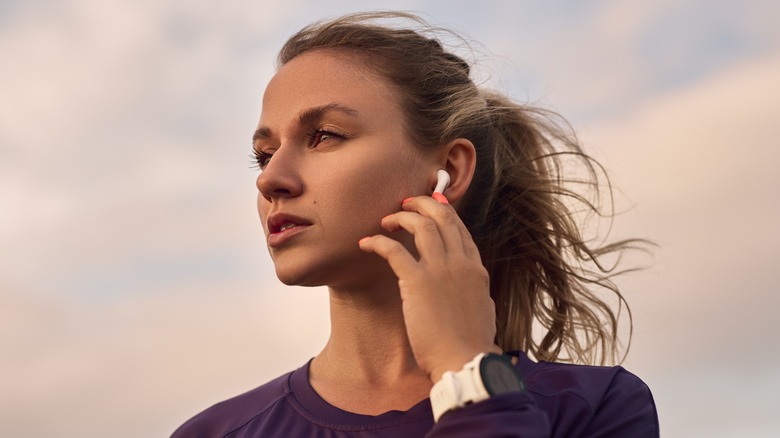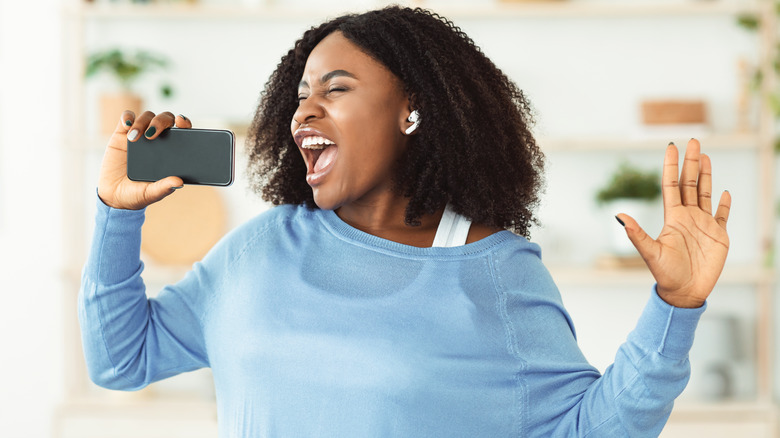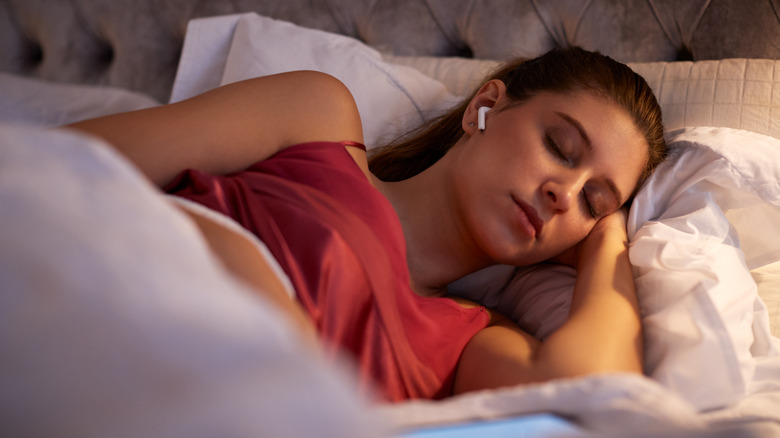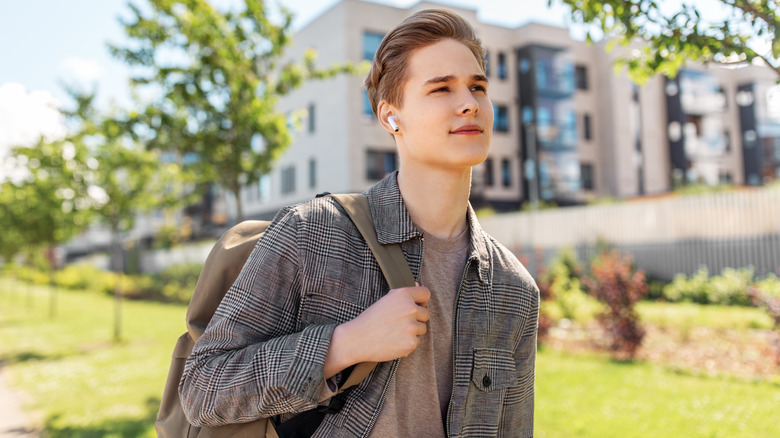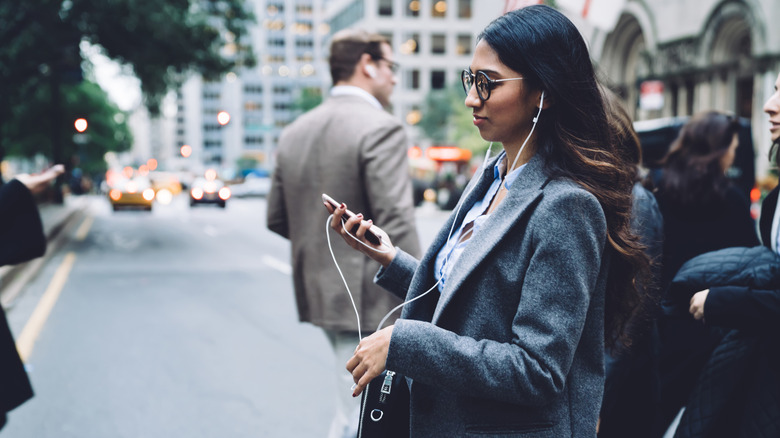Surprising Side Effects Of Using Earbuds
Earbuds are quickly becoming a staple of everyday life. Busy schedules and days on the go mean that audiobooks, news shows, and podcasts are the easiest to keep up with. And music lovers know just how valuable a good daily playlist can be when you need to keep your mood up. But as helpful as they are, there are some side effects most people don't know about. They range from mildly annoying to potentially dangerous. It all comes down to the kind of earbuds you have, how you care for them, the volume you set them to, and how often you use them.
Of course, the big benefit to earbuds is that they send sound directly down your ear canal. Less outside noise interferes with your music or the narrator you're trying to pay attention to. But doctors have warned against this design for years, at least for people who like a lot of volume. As Whittier Hospital warns, high volumes delivered directly down the ear canal can rupture a person's eardrum. It's incredibly painful, yes, but it can also lead to permanent hearing loss. Plus, other side effects can occur.
Increased risk of ear infections
Whittier Hospital warns that earbuds lead to earwax buildup, which is a good way to develop an ear infection. This risk only compounds when earbud hygiene is factored in. You may take the time to wrap your earbuds' cord so it doesn't tangle, but how often do you clean your earbuds? Eek.
In addition, leaving earbuds in for long periods of time obstructs the natural airflow that our ears would otherwise be exposed to from the environment (via The Conversation). Without this circulation, sweat, water, and moisture linger in your ears. Because earwax is not water-soluble, the trapped moisture causes earwax to become soft and sticky and prevents it from drying out, leaving you susceptible to the development of bacterial and fungal infections (via The Healing Journal). Ear infections can be avoided with regular earbud maintenance. If you're unlucky enough to get one, though, they can usually be also easily treated.
No, your earbuds won't give you cancer
Fans of cordless headphones might have heard that they're at risk for more dangerous side effects, including cancer. This is, thankfully, not true. In 2015, a group of 247 scientists from 42 countries wrote a letter to the World Health Organization asking them to issue carcinogen warnings against 5G wireless as well as Bluetooth devices. This idea gained traction when a guest writer posted a warning to the blog for Scientific American. The post has since been removed and rewritten, as well as debunked by the American Council on Science and Health.
The concern is rooted in studies around people who were exposed to high levels of EMF radiation, according to the National Cancer Institute (NCI). Subjects included those who work in power transfer stations (with power lines) and military members who worked in close contact with high-frequency radios. Given the regular use of cell phones and wireless earbuds, some scientists are concerned that the same risks now apply to everyday people.
The WHO, the CDC, and the NCI are not convinced, however. All three organizations have weighed the evidence and found no viable evidence that EMF exposure from our everyday devices can cause cancer. Cellphones and earbuds just don't give off enough radiation to cause cancer.
Sleeping with earbuds in can cause infection and wax buildup
According to the Cleveland Clinic, sleeping with ill-fitted earbuds can be particularly troublesome — especially for side sleepers. At a minimum, the extra pressure placed on your ear when your head hits the pillow can cause short-term discomfort. But unfortunately minor pain isn't the only issue. When you insert earbuds into your ear, you may be inadvertently upping your risk of infection. This is particularly true for those who like to shower before bed, trapping moisture inside and creating a prime environment for bacterial growth.
Additionally, the Cleveland Clinic suggests that excess wax can build up in your ear as a result of wearing earbuds for too long — like during the 6-8 hours of sleep you may be getting each night. This is primarily due to the fact that whenever you push something into your ear, any wax that's already inside gets pushed back even deeper. This can cause unpleasant symptoms like ringing in the ears and even hearing loss.
Effects on concentration and focus
While the research is mixed, the type of audio streaming through your earbuds while hard at work may increase or decrease your ability to focus — so you'll want to choose wisely (via The Wall Street Journal). Listening to songs with lyrics can overload the brain, especially while simultaneously reading or writing. Noise-canceling earphones may be more beneficial for focus as they can be effective at reducing distracting workplace noise.
As for the types of music to stream through your earbuds, a 2022 study published in Frontiers in Computational Neuroscience may be able to shed light. Researchers compared how silence, popular music playlists, and soundscapes impacted focus on subjects who were asked to complete a series of computer tasks. Soundscapes had the most comparable effects to silence. Additionally, soundscapes and classical music were most effective at increasing focus, while pop and hip-hop genres were the least.
Increased risk of accident or injury
If you walk around on the daily wearing earbuds — particularly noise-canceling ones — you are likely increasing your risk for accident or injury. If you're crossing a busy street, your earbuds are blocking out sound and thereby reducing your ability to respond to an emergency, such as the warning honk of a car horn or the sound of oncoming traffic.
In a retrospective study of headphone-related accidents in the United States, researchers pulled records from various databases between 2004 and 2011 specific to train or automobile accidents that resulted in pedestrian injury or fatality. 116 of these reports involved instances of pedestrians wearing headphones. Outcomes revealed that males made up the majority of victims totaling 68% of injured or deceased pedestrians. Additionally, 67% of those struck were under the age of 30. In over 70% of the cases, the pedestrian was reportedly wearing headphones at the time of the crash. Nearly 30% of accidents reported that a warning sound had been issued prior to the collision.
The rules of earbud safety
When it comes to wearing earbuds, it's important to do so safely. This is especially important for children and adolescents. In fact, 17% of teenagers experience some level of hearing loss, with music-blaring headphones partially to blame (via Audio Mav).
To ensure you're keeping your ears safe and healthy, doctors suggest abiding by the "60%/60-minute rule" (via Nemours). For avid music listeners, video game players, and movie watchers, this means you'll want to make sure your audio isn't exceeding any more than 60% of the device's maximum volume. Additionally, earbud usage should be kept to 60 minutes or less in order to give your ears a sufficient break.
When in doubt, you can always utilize the ears around you to check whether or not your earbud volume is too loud — meaning if a friend, family member, or stranger sitting nearby can clearly hear what you're playing, your music is likely at an ear-damaging volume and should be turned down. So, enjoy your earbuds. Just keep the volume low, the cords untangled, and the buds clean!


